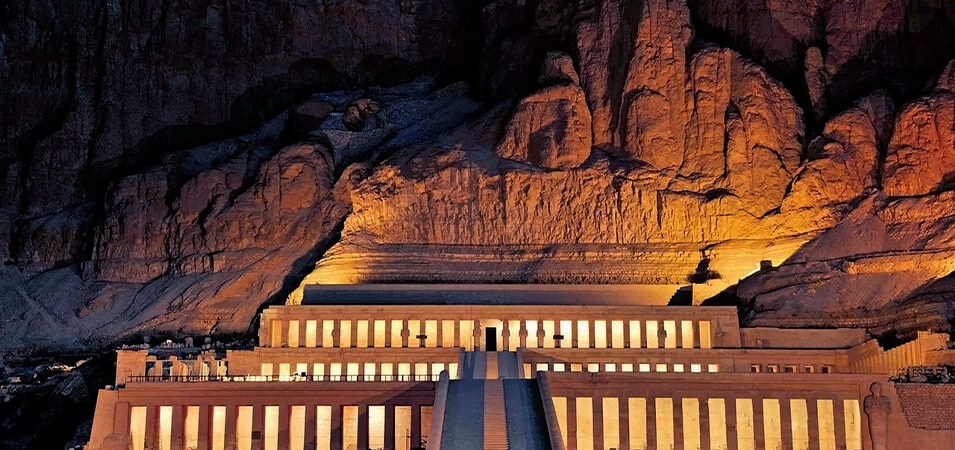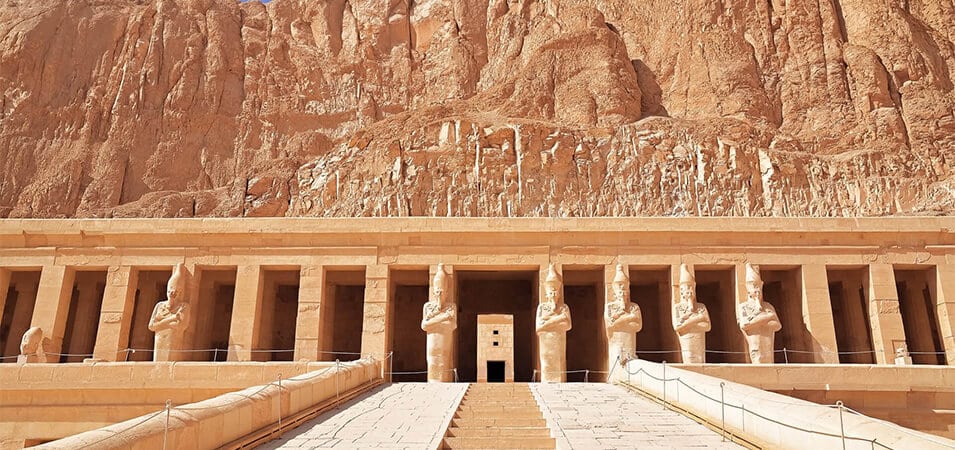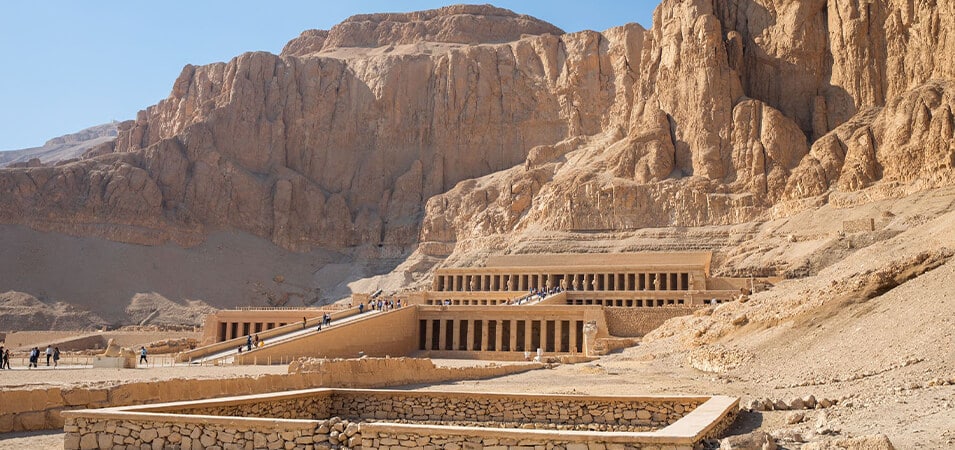Egypt is a beautiful country with many fantastic old buildings with a lot of historical and cultural value. The Hatshepsut Temple in Luxor stands out among these architectural marvels because it shows how powerful and successful one of Egypt’s most famous kings was.
The Hatshepsut Temple in Egypt’s old city of Luxor is a beautiful piece of architecture that shows how great the ancient Egyptians were. This temple was built during the time of Queen Hatshepsut, one of Egypt’s most exciting pharaohs. It is a reminder of her time in power and her lasting impact. The Hatshepsut Temple is a must-see for anyone interested in ancient Egyptian history and culture.
It has a fantastic design, beautiful artwork, and essential historical meaning. This article discusses the Hatshepsut Temple’s exciting history, beautiful design, cultural value, and practical tips for going there.
Don’t Miss checking out our Egypt Tour Packages.
The History of Hatshepsut Temple

- The Hatshepsut Temple, also called the Deir el-Bahari, was built in the 15th century BCE when Egypt was in the New Kingdom. Queen Hatshepsut, often called the “Female Pharaoh,” became ruler when women were not usually in charge.
- She was there for over 20 years, from about 1479 to 1458 BCE. During Hatshepsut’s rule, the government was stable, the economy was doing well, and she built some impressive buildings. The temple was built on the west bank of the Nile, across from the city of Thebes, which is now called Luxor. Senenmut, the builder, intended to honor both Hatshepsut and the sun god Amun-Ra. The temple was a place of prayer, a place to bury people, and a memorial to the queen’s divine lineage and pharaonic power.
Architectural Features
- The Hatshepsut Temple is a beautiful architecture that perfectly fits in with the Theban Mountains. It has a dramatic appearance because it consists of three terraces connected by ramps. On the lower terrace are Hatshepsut statues on the colonnades, and a group of sphinxes guard the door.
- The middle deck has a big courtyard and an open arcade with reliefs that show the queen’s accomplishments, religious ceremonies, and trading trips. The most noticeable thing about the temple is the upper terrace, where the central sanctuary is located.
- There are chapels for Amun-Ra, Hathor, and Anubis in this shrine. Bright reliefs on the walls show religious scenes, mythological stories, and Hatshepsut’s birth as a god. The Hatshepsut Temple of the Dead has both natural and artificial parts. The wild cliffs serve as a backdrop, and the building fits in perfectly with the rocks. The temple’s design is based on divine harmony between the earthly and heavenly worlds. The terraces represent the journey to the skies.
Cultural Significance of Hatshepsut Temple
- The art in the Hatshepsut Temple is essential from a historical and cultural point of view. The temple contains reliefs and inscriptions that tell much about ancient Egyptian religion, customs, and daily life. These detailed carvings show religious events, god offerings, and the queen’s royal rituals. The trip to the Land of Punt is one of the most famous scenes in the temple. These reliefs show the journey to a faraway land, consider what is now Somalia, to trade for valuable things like incense, unusual plants, and animals. This expedition shows how good Hatshepsut was at trading and how wealthy and powerful ancient Egypt was during her reign.
- The Queen Hatshepsut figures that decorate the temple are just as impressive. In these figures, she is made to look like a male pharaoh, complete with a beard and other symbols of pharaonic power. Hatshepsut was shown as a male pharaoh on purpose. This was done to show that she was Egypt’s true ruler and legitimize her rule. Hatshepsut Temple is critical to religion because it is where worship and offering practices for Amun took place. The walls and columns of the temple are covered with colorful hieroglyphs and beautiful artwork that tell the story of Hatshepsut’s rule and holy lineage. These writings give us essential information about how politics and religion worked in ancient Egypt.

Preservation Efforts and Tourism
Over the years, the Hatshepsut Temple was damaged by natural wear and tear and by people. But much work has been done to fix it and keep this important cultural heritage alive. Many repair projects have been done on the temple, ensuring its structure is sound and the intricate artwork is safe. The Hatshepsut Temple is one of the most visited places in Luxor today. People come from all over the world to see the beauty of its architecture and learn about the history of old Egypt. By looking around the temple, visitors can follow the steps of Queen Hatshepsut and learn more about her rule and ancient Egyptian culture.
Archaeological Discoveries
- Archaeological digs at the Hatshepsut Temple in Luxor have revealed interesting finds that tell us more about ancient Egypt. Archaeologists have seen an incredible trove of information at the site. They have discovered hidden secrets and learned a lot about how people built things and how they worshipped back then. There are intricately carved reliefs at the temple that show scenes from Hatshepsut’s reign and show off her divine position and accomplishments.
- Fragments of statues, obelisks, and ceremony items have also been found. These show how rich and grand the temple was. Archaeologists have also found hidden rooms and passages inside the temple complex. This has helped them figure out the complicated layout and design of the building. These discoveries have taught us much about how the building was built and what it meant symbolically. Each new archeological find at the Hatshepsut Temple helps us learn more about ancient Egypt and enjoy the rich cultural history kept inside its walls.
Visiting Hatshepsut Temple
Seeing the Hatshepsut Temple in Luxor is an awe-inspiring thing to do. As you walk through the temple’s terraces, you can’t help but be amazed by its beautiful architecture and the detailed reliefs that show how people lived in ancient Egypt. The statues of Queen Hatshepsut and the beauty of the temple take you back in time. Exploring the temple gives you a sense of how vital this queen was in history and how great the society she led was. The Hatshepsut Temple is a must-see for anyone who likes history, buildings, or is just interested in ancient Egypt. It gives a fascinating look into Egypt’s rich past.

FAQs to Hatshepsut Temple in Luxor
What are the opening hours of Hatshepsut Temple?
Hatshepsut Temple is generally open from 6:00 AM to 5:00 PM. It is advisable to check the specific timings before your visit.
Is Hatshepsut Temple accessible for individuals with mobility issues?
Some steps and uneven surfaces in the temple complex could be hard for people with trouble moving around. But there have been attempts to make some places easier to get to.
Q3: What is the best time to visit Hatshepsut Temple?
The best time to visit the Hatshepsut Temple in Luxor is usually from November to February when it is cooler. During this time, the weather is more pleasant, with temperatures ranging from mild to warm. Summer can get very hot, making walking around the temple complex less fun.
How long does it take to explore the entire temple complex?
How long it takes to see the Hatshepsut Temple complex in Luxor depends on people’s interests and the information they want. People spend between 2 and 3 hours looking around the temple complex.
Are there any restrictions for photography inside the temple?
Inside the Hatshepsut Temple complex, you can usually take pictures. People can take photos of the temple’s architecture, reliefs, statues, and scenery. Taking pictures to remember your trip and show off the fantastic art is a usual thing to do.
Is there a dress code for visiting the temple?
There are rules about what to wear at the Hatshepsut Temple and other religious places in Egypt. Because of these places’ cultural and religious importance, it is best to dress modestly. Men and women should both wear clothes that cover their shoulders and knees. Since Luxor can get very hot, it’s best to wear clothes that fit loosely and aren’t too heavy.
Are guided tours available at the temple?
The Hatshepsut Temple in Luxor does offer trips with guides. Many tour companies and travel agencies offer guided tours that tell you about the temple’s history, design, and importance.
Can visitors climb the temple’s terraces?
Most tourists to the Hatshepsut Temple in Luxor cannot climb the temple’s terraces. Climbing on the decks and buildings of the temple is not allowed to protect the old site and keep it safe.
Conclusion
The Hatshepsut Temple in Luxor is an excellent example of how strong, intelligent, and visionary Egypt’s first female queen was. It is a must-see for history buffs and fans of ancient cultures because of its historical importance, beautiful architecture, and cultural significance. As you follow the steps of Hatshepsut, you will learn more about Egypt’s rich history and the vast effect this remarkable ruler had.
Don’t Miss checking out our Related Article :
